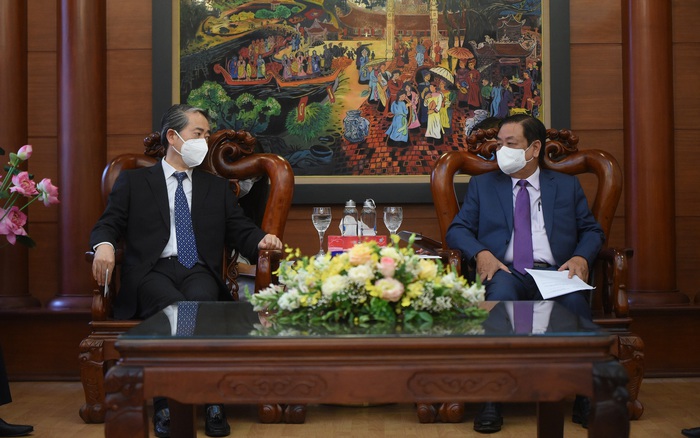
At the invitation of Chinese Premier Li Qiang, Vietnam Prime Minister Pham Minh Chinh will attend the 20th ASEAN-China Expo (CAEXPO) and the China-ASEAN Business & Investment Summit (CABIS) held in Nanning, Guangxi region, China during September 16-17, 2023.
The two countries exchanged many high-level visits in recent years, contributed to raising comprehensive cooperation between Vietnam and China to a new height. Particularly, the two Governments give close attention and clear direction for agriculture and rural development.
Currently, China is Vietnam’s largest trading partner and largest export market. It has surpassed the US to become the first largest export market for agricultural, forestry and fishery products in the first 8 months of 2023.

Potential for agricultural, forestry and fishery trade
With its population of more than 1.4 billion people, accounting for 18.7% of the world population), the Chinese market has a large and diverse need to import goods, agricultural and aquatic products to serve domestic consumption and export processing.
Vietnam’s export turnover of agricultural, forestry and fishery (AFF) products to this market achieved a rapid and stable increase in recent years. In the period 2016-2021, AFF trade (export and import) between Vietnam and China increased from 8.57 billion USD in 2016 to 12.06 billion USD in 2021 (an annual average growth rate of 8.02%). AFF export value to China accounts for 20.76% of the total AFF export value (General Department of Vietnam Customs, 2021). Vietnam’s main export products to China include rubber (2.29 billion USD), vegetables (1.90 billion USD), wood and wood products (1.50 billion USD), cassava and products from cassava (1.1 billion USD), and aquatic products (976.4 million USD), etc.
In the first 8 months of 2023, AFF import-export turnover between Vietnam and China reached over 9.3 billion USD, an increase of 3.2% year-over-year. Particularly, Vietnam’s AFF exports to China are estimated to reach 7.28 billion USD, an increase of 9.8% year-over-year while Vietnam’s AFF imports from China are estimated to reach 2.04 billion USD, a decrease of 19.3% year-over-year. AFF trade surplus reached over 5.2 billion USD, an increase of 33.3% year-over-year.
There are similar geographic features and climate between southern provinces of China and Vietnam, that lead to a quite similar Vietnamese AFF consumption in China, especially for rice, seafood, vegetables, and fruits. As a close neighbors, China is an important target market for Vietnam’s fresh products such as vegetables, fruits and seafood.
Vietnam has a big potential for AFF exports to China in recent years. The growth rate only decreased in the period 2020-2021 due to impacts of Covid-19 pandemic in addition to China’s “Zero Covid” Policy resulting in certain difficulties in customs clearance process at land border gates.
Up to present, China has granted import licenses for 12 fruit, vegetable and milk products, 805 seafood processing facilities, 40 live crab and lobster packaging facilities and 5 black tiger shrimp and whiteleg shrimp packaging facilities besides 128 species/product types and 48 aquatic species from Vietnam. It also agreed to pilot import of passion fruit and chili from Vietnam. China authority has also coordinated with the Vietnam Ministry of Agriculture and Rural Development to conduct an online survey and assessment of Vietnam’s ability to export coconuts to China. Moreover, the two sides are closely coordinating to complete the “Investigation and assessment of the safety management system for frozen durian exported to China” and facilitate early signing of 02 Protocols on phytosanitary requirements for Vietnamese chili peppers and medicinal herbs exported to Chinese market.
More comprehensive, substantive and effective agricultural cooperation
Up to present, the Ministry of Agriculture and Rural Development of Vietnam (MARD) and its Chinese partners have signed and implemented 20 Agreements/ Memorandums of Understanding (MOU)/ Protocols of various types in the field. This forms a solid legal basis for the two sides to establish premise for the development of agricultural, forestry and fishery trade between the two countries.
From the beginning of 2020 to the beginning of 2023, despite highly complicated Covid-19 pandemic, the Vietnam Ministry of Agriculture and Rural Development successfully maintains and promotes relationships with China (Ministry of Agriculture and Rural Development, General Department of Customs, and Chinese Embassy in Vietnam, etc.).
From May 29th to June 2nd, 2023, the working delegation of the Vietnam Ministry of Agriculture and Rural Development led by Deputy Minister Tran Thanh Nam visited and worked with two provinces of Guangxi and Yunnan of China to enhance cooperation between MARD and the two provinces.
Currently, MARD is completing the Memorandum of Cooperation (MoC) with the People’s Government of the Guangxi Zhuang Autonomous Region which is expected to be signed on September 16, 2023 during Vietnam Prime Minister Pham Minh Chinh’s visit of the 20th China-ASEAN Business & Investment Summit (CABIS) held in Nanning, Guangxi region, China. The Memorandum of Cooperation between the MARD and Yunnan province is expected to be completed and signed in 2023.
Besides trade exchange, both Vietnam and China are paying attention to many other areas in agriculture.
Research institutes and universities/colleges under the Vietnam Ministry of Agriculture and Rural Development currently have many highly practical cooperation programs with Chinese institutes/universities that solve many practical problems in science and technology, especially for plant and animal breeding.
***
According to Mr. Nguyen Do Anh Tuan, Director General of International Cooperation Department, MARD, Vietnam has taken measures to adjust production to meet the increasing quality requirements of the Chinese market.
Firstly, it maintains current stable market share of agricultural products (fruits, tapioca starch, and seafood) exported through northern border gates while increasing the added value of official-quota export products and the export of processed agricultural products (PAPs) to large cities such as Beijing and Shanghai, etc.
Secondly, it is necessary to improve the infrastructure system to serve export activities toward mutual investment by the state and businesses to increase the capacity to provide logistic services, bonded warehouses, tax-suspension warehouses, CFS warehouses, and form agricultural product supply centers in border gate areas.
Additionally, it is essential to build a number of agricultural logistics supply chains between Vietnam and China with the participation of large Vietnamese and Chinese enterprises in official-quota exports to create pervasiveness and promote synchronous logistics infrastructure development and gradually reduce unofficial-quota exports.
It also promotes official-quota exports, ensures exported AFF products are standardized and synchronized in quality, packaging, labeling, food safety and hygiene, and food traceability, with logo, trademark, and national brand.
At the same time, it is vital to bring into focus communication, propaganda, and warnings in addition to training support and awareness raising for businesses to promptly respond to such changes in China’s trade policy as Covid-19 pandemic.
It is practical to expand access to distribution channels in major cities and key localities of China through cooperation with Chinese associations and wholesale and retail businesses.
Finally, it is needed to strengthen the connection between Vietnamese and Chinese businesses through the establishment of the Vietnam AFF Exporters Association to connect and facilitate import and export of agricultural products between Vietnam and the two provinces of Guangxi and Yunnan of China.





